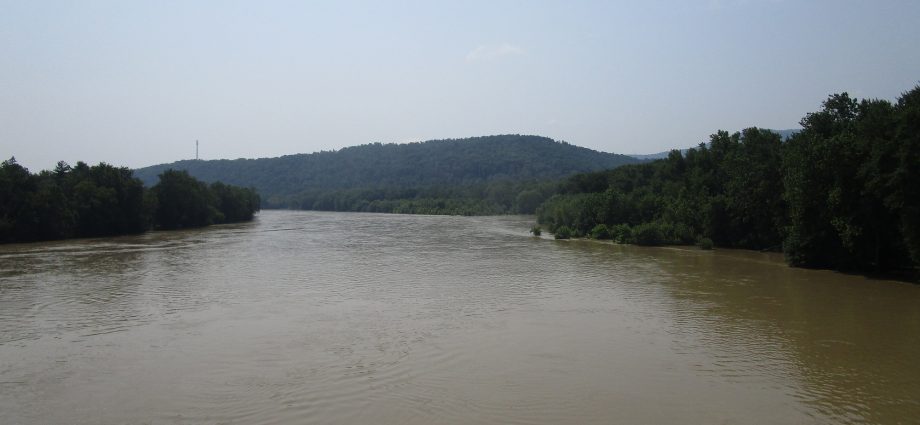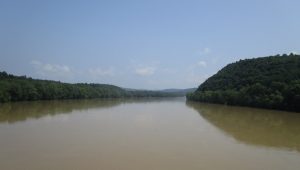The Susquehanna River, as seen on Monday from the Mehoopany Route 87 Bridge in Wyoming County, was moving swiftly and climbing its banks. The Kiwanis Club of Tunkhannock was forced to postpone its annual canoe/kayak race on Sunday and hopes to be able to conduct the event on Aug. 1. It has dropped a bit today, but thunderstorms forecast for Tuesday evening into Wednesday will likely push it back up again.
By Rick Hiduk
(Exclusive to EndlessMtnLifestyles.com readers)
Persistent rains since spring have filled the Susquehanna River to near bank full several times already this year. While flooding concerns have been minimal, the nearly constant high water has been challenging for people who rely on the waterway for summer recreation. There is no official warning system in either Bradford nor Wyoming counties that provides recreational river condition alerts, so kayakers and those hoping to fish are urged to be mindful of conditions and stay away from the water until it recedes and the banks have time to dry.
Emergency management officials in both counties rely on experienced outfitters and guides to make appropriate decisions for their clients. Those who are accustomed to taking to the river on their own are encouraged to monitor USGS river gauges, four of which are situated between Waverly, NY, and Wilkes-Barre in Luzerne County. There are also stream gauges on the Chemung River, which meets the Susquehanna River at Athens, and on Towanda and Tunkhannock Creeks.
“We would recommend that prospective river patrons monitor the USGS Gauge Network prior to embarking on a float, especially after a high water event that typically will reposition gravel bars and debris that could create hazardous conditions,” said Bradford County director of public safety Matt Williams.
Wyoming County EMA director Gene Dziak echoes those sentiments. “Right now, you need to be extremely careful on the river,” he stated. Dziak participated this week with area first responders on rescue drills with an air boat and reported the river to be high, fast and muddy. To anybody thinking about accessing the river at this time, Dziak suggested, “We would hope that when they look at the river, they say, ‘I don’t want to be out on that!'”
So, how high is too high? Endless Mountains Lifestyles asked three people who would be on the river almost every day if conditions allowed, and their responses were similar.
“High water and rainy weather are a constant battle for outdoor activities,” said Keith Brown, owner/operator of Endless Mountains Outfitters, which is headquartered in Sugar Run in Bradford County. “It’s very important to stay safe and never chance getting hurt.”
“We have not run any trips since July 6, when flash floods caused the river to rise above our safe level,” said Art Coolbaugh, owner/operator of Susquehanna Kayak & Canoe Rental, based in Falls, Wyoming County. Coolbaugh relies on the Wilkes-Barre gauge (https://water.weather.gov/ahps2/hydrograph.php?wfo=bgm&gage=wbrp1 ) and will not put customers on the water if it is above five feet there. “At this level, the water is very muddy, and debris starts to flow down the river as well, further hampering paddlers on the river. Should someone capsize at this level, it is difficult for them to get to shore and upright their craft.”
“There can be trees, LP tanks – anything that’s close to the shore – floating in the water,” noted Dziak, adding that fallen trees along the shoreline and those partially submerged – often referred to as stringers because of their potential to separate recreationists from their vessels – present another danger. “If you get caught in a stringer and pulled under, you’re going to be in trouble.”
Lance Dunham, owner/operator of LD Guide Service in Bradford County, monitors the Towanda river gauge (https://water.weather.gov/ahps2/hydrograph.php?wfo=bgm&gage=towp1 ) daily. “If it gets over 4 ½ feet, I’ll contact my charter and see if they want to fish in poor water conditions,” he related. “Once it gets to six feet, I cancel and reschedule if possible because, at that height, we start to see parts of trees and too much debris on the river to safely go fishing.”
Boaters aren’t Dziak’s only concern. He’s responded to emergency calls from anglers falling into the swirling brine from the shoreline. “It’s very slippery right now. If you try to get closer, it can suck you in.”
As of 4 pm on Tuesday, all of the river levels were above what our experts consider safe; Towanda at 6.6 ft; Wilkes-Barre at 11.2 ft; and, in between, the Susquehanna River at Meshoppen was at 17.4 feet (https://water.weather.gov/ahps2/hydrograph.php?wfo=bgm&gage=mhpp1 ).
Dunham, Coolbaugh, and Brown agree that high water events on the Susquehanna are nothing new, but they seem to be occurring at a greater frequency. Brown has owned Endless Mountain Outfitters for four years and remarked that he has seen heavy rain, high water and flooding during three of those years. Both he and Coolbaugh have taken earnest paddlers to nearby lakes as an alternative, but the constant chance for thunderstorms still presents the danger of lightening strikes.
Even Dunham, who has professed to not being a big fan of lakes, ponds, or even streams, has offered clients the option of pond fishing until the river goes down and stays down.
River lovers need not give up hope, however, Brown related. “The river does go up, but it goes down quickly too. If you aren’t sure, call your local outfitter and get their recommendation.”

